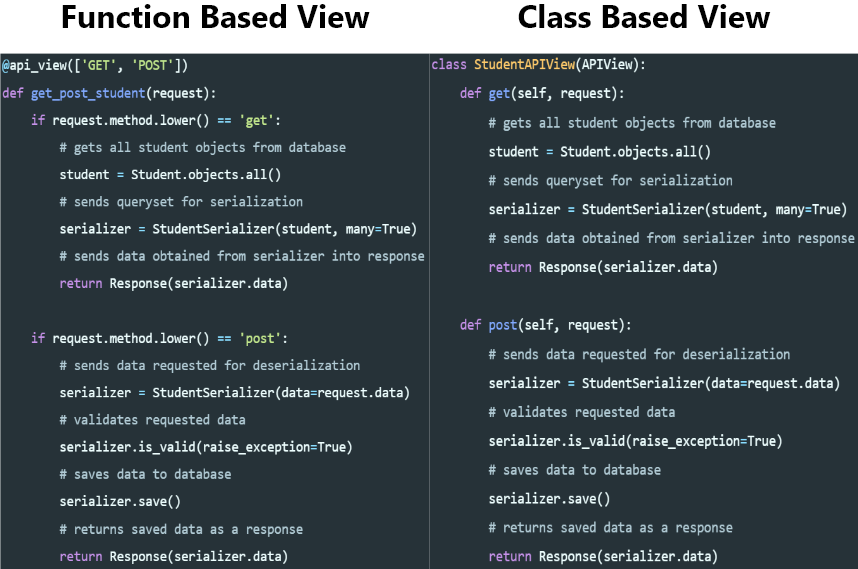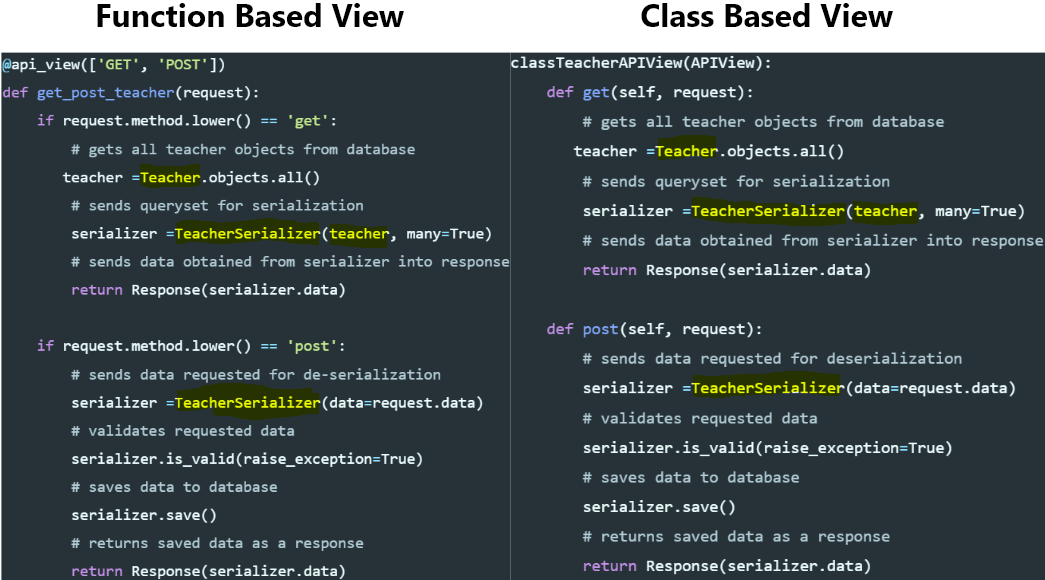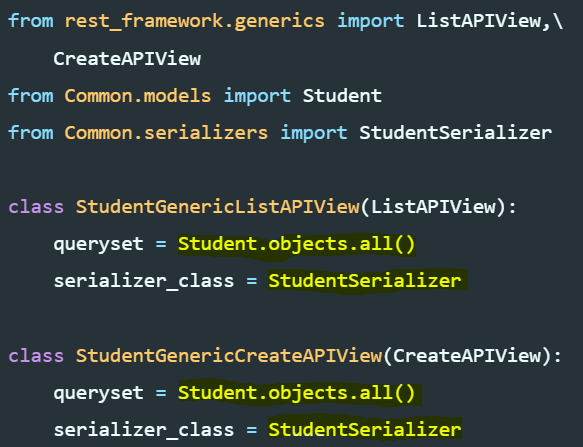Generic Views-Django Rest Framework
 Generic views are designed as a shortcut for common usage patterns.The common patterns used while building views is abstracted so that we can build our common views quickly without having to repeat code ourself.
Generic views are designed as a shortcut for common usage patterns.The common patterns used while building views is abstracted so that we can build our common views quickly without having to repeat code ourself.
Let’s suppose that our requirement is to create an api where we can post student data and get list of all the student’s data.
First thing first, let’s build model and serializer.
Model
1
2
3
4
5
6
7
8
from django.db import models
class Student(models.Model):
first_name = models.CharField(max_length=10)
last_name = models.CharField(max_length=10)
email = models.EmailField()
age = models.PositiveSmallIntegerField()
number = models.CharField(max_length=15)
Serializer
1
2
3
4
5
6
7
8
9
from django.db import models
from rest_framework import serializers
from Common.models import Student
class StudentSerializer(serializers.ModelSerializer):
class Meta:
model = Student
fields = "__all__"
Before using generics views to solve our problem, let’s look at function based and simple class based approach of solving it.
Function Based View
1
2
3
4
5
6
7
8
9
10
11
12
13
14
15
16
17
18
19
@api_view(['GET', 'POST'])
def get_post_student(request):
if request.method.lower() == 'get':
# gets all student objects from database
student = Student.objects.all()
# sends queryset for serialization
serializer = StudentSerializer(student, many=True)
# sends data obtained from serializer into response
return Response(serializer.data)
if request.method.lower() == 'post':
# sends data requested for deserialization
serializer = StudentSerializer(data=request.data)
# validates requested data
serializer.is_valid(raise_exception=True)
# saves data to database
serializer.save()
# returns saved data as a response
return Response(serializer.data)
Class Based View
1
2
3
4
5
6
7
8
9
10
11
12
13
14
15
16
17
18
class StudentAPIView(APIView):
def get(self, request):
# gets all student objects from database
student = Student.objects.all()
# sends queryset for serialization
serializer = StudentSerializer(student, many=True)
# sends data obtained from serializer into response
return Response(serializer.data)
def post(self, request):
# sends data requested for deserialization
serializer = StudentSerializer(data=request.data)
# validates requested data
serializer.is_valid(raise_exception=True)
# saves data to database
serializer.save()
# returns saved data as a response
return Response(serializer.data)
We saw the class based and function based views above to solve our problem. But what our generics views will look like? Excited? Let’s meet our generic view.
Generic View
1
2
3
4
5
6
7
8
9
10
11
12
from rest_framework.generics import ListAPIView,\
CreateAPIView
from Common.models import Student
from Common.serializers import StudentSerializer
class StudentGenericListAPIView(ListAPIView):
queryset = Student.objects.all()
serializer_class = StudentSerializer
class StudentGenericCreateAPIView(CreateAPIView):
queryset = Student.objects.all()
serializer_class = StudentSerializer
Is this your first meet with generic? If the answer is yes!, you might have found him really confusing. But don’t worry generic was confusing to me too when i first met him. I had a lots of question like
- Does this view even work?
- Don’t we have to check the incoming request method?
- Don’t we have to send data for serialization or de-serialization?
- And where is the response?
- Don’t we have to send response to the front end?
The single word answer to all the above question is yes but its not us who does that all now, it’s the generic view that handles all the common patterns in views.
We have been talking about common patterns a lot, so what is common pattern? Can we identify any common pattern from class based view and function based view?
To understand it more clearly let’s look at a views to create an API where we can post teacher data instead of student and get list of all the teacher’s data.
Now we know that everything is common except for those highlighted ones.
So, what are the uncommon ones above?
1) Model object is different. (Teacher instead of Student)
2) Serializer class is different. (TeacherSerializer instead of StudentSerializer)
And what are the common patterns?
Common Patterns in GET
1) Getting all the objects of related model.
2) Sending queryset for serialization.
3) Returning data from serializer into response.
Common Patterns in POST
1) Sending requested data for de-serialization
2) Checking if the requested data is valid.
3) Saving the validated data.
4) Returning data from serializer into response.
Conclusion: That’s why generic views has attributes queryset and serializer_class to take the uncommon ones and generate all the common patterns under the hoods so that we do not have to repeat the code, allowing us to build an api quickly.








Leave a comment